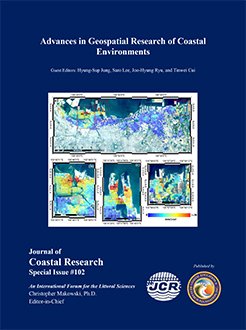Choi, D.-L.; Shin, D.-H.; Jin, J.-Y.; Lee. Y.-K., and Kum, B.-C., 2020. High-resolution seismic stratigraphy offshore Haeundae beach in Busan, South Korea. In: Jung, H.-S.; Lee, S.; Ryu, J.-H., and Cui, T. (eds.), Advances in Geospatial Research of Coastal Environments. Journal of Coastal Research, Special Issue No. 102, pp. 187-193. Coconut Creek (Florida), ISSN 0749-0208.
The stratigraphic architecture of the Haeundae shallow sea was evaluated using numerous high-resolution single-channel seismic profiles and drilled cores. Two major seismic units over the basement, the lower Unit II and upper Unit I, as well as two subunits (Units Ia and Ib) in the upper Unit I were identified in the study area. Unit II shows numerous chaotic diffraction hyperbolic seismic reflection patterns overlying high amplitude, and irregular reflection of the bedrock surface, corresponding well with the gravel-dominated deposits. Unit II is interpreted as nonmarine alluvial deposits in the Quaternary glaciations. Unit I is present over Unit II with two distinct subunits at different locations: Unit Ia, distributed inshore within ∼10 m depth, and Unit Ib, offshore beyond ∼13 m depth. Unit Ia, which is accumulated more in the western inshore section, exhibits an acoustically semi-transparent and sigmoidal clinoform wedge and is well correlated with sand-dominated deposits from core data. Unit Ib, which pinches out landward but gradually thickens seaward, is generally characterized by transparent seismic facies, likely made up of very fine sandy to muddy sediments from surface sediments. The depositional environments of Units Ia and Ib are categorized as shoreface settings and the landward innermost part of the Nakdong distal delta system during late Holocene sea-level highstand, respectively. Due to severe weather conditions associated with winter storms and summer typhoons as well as human interventions, the sediment morphology and its distribution are thought to have constantly been reactivated and modified.





